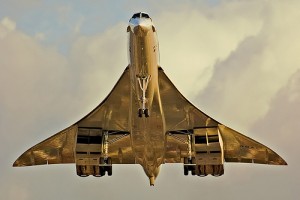
British Airways Concorde landing at Heathrow in 2003.
When the TU-144 and Concorde first went into service in the 1970’s , it was a time of aviation excitement. Both aircraft had the promise to completely revolutionize commercial transportation, providing speeds over twice the speed of sound (around 1100 mph vs 500-600 mph for other commercial airliners). Most thought the supersonic transport (SST) would replace other aircraft, to become the norm in general aviation. It was thought the sonic boom experienced when a jet goes over the sound barrier would become part of daily life, and people would be willing to live with them to have fast transportation.
The Tupolev TU-144 was the first SST to take flight in December 1968, two months before the Concorde. The TU-144 hit a big setback when the first production aircraft crashed during the 1973 Paris Air Show, killing all six crew members aboard and 15 people on the ground. Then in 1978 another TU-144 crashed during a pre-delivery test flight, killing all aboard. The aircraft type flew 55 passenger flights with Aeroflot before it was pulled from service in June of 1978, less than ten years after its first flight.
At the time Boeing was also working on their own SST, the Boeing 2707. The US didn’t want Europe and Russia to have the monopoly on SST technology, so the US government funded a contract for Boeing to study making its own. In 1963 the National Supersonic Transport program subsidized 75% of development costs to help Boeing directly compete with the TU-144 and Concorde. Since the Concorde and TU-144 were almost twins, Boeing wanted to make something different and were aiming to make a 250 passenger SST, which would hold about twice the passengers of the other two. In March 1971, funding for the project was canned by Congress and although private funding was able to raise nearly $1 million, the entire project was shut down in May of 1971. At the time, the Boeing 2707 had 115 orders from 25 airlines and the Concorde only had 74 order from 16 customers.
The Concorde and Tu-144 might have looked similar, but Arospatiale-BAC’s Concorde was superior in its avionics and capabilities. It has its first flight in March of 1969 and entered service in 1976. During that time, the first two prototypes traveled the world to build excitement and there were 70 orders for the plane. However, many orders were canceled after an oil crisis caused financial difficulty for the airlines, the crash of the similar TU-144, and concerns about the sonic-boom not being acceptable in populated areas. In the end, only British Airways and Air France took delivery of the Concorde. The plane was flown until 2003 when Air France flight 4590 crashed in France killing all 109 people aboard and raising questions about the safety of the aircraft. The aircraft was retired on November 26, 2003.
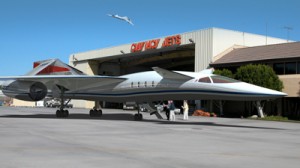
Supersonic Aerospace International's QSST rendering.
There was hope in the early 90’s for a resurgence of SST when a wealthy businesswoman, Judith DePaul, worked with Tupolev and NASA to use a TU-144 as a testbed for additional SST research. Over $350 million was spent on retrofitting the mothballed Tu-144 and it made a total of 27 flights through the 90’s, but was canceled in 1999 for “lack of funding.” Today, the aircraft is rusting away in storage with little hope of being used again.
It has been over 40 years since the first SST flight occurred and almost 6 years since the last SST commercial flight. It has seemed unlikely there will be a revival of the Concorde or TU-144, but there might be hope on the horizon. The biggest hurdle has been the sonic-boom heard when an aircraft passes the sound barrier. The loud and disruptive boom caused previous SST’s to be flown only over water. Scientists are currently working on ways to “shape” the boom, making it sound more like distant thunder, something that the general public could live with to allow flights over land.
Even if the technology becomes available, it is not going to be cheap. A round trip ticket from New York to London on the Concorde before its cancellation ran about $10,000.00 USD. However, history has shown new technology can be expensive at first but as it develops can become more cost effective. The Concorde didn’t have time to become less costly since the technology became stagnant.
It would be a long while before Boeing or Airbus would start seriously considering making a SST line of aircraft. But smaller business jet companies are spending good sums of money researching new technology that is being dubbed Quiet Supersonic Transport (QSST). Supersonic Aerospace International is working on creating the next generation of SST starting in the business jet realm. They are hoping to have their first aircraft flying by 2014 with first customer delivery in 2016. Even if they wouldn’t be able to make those optimistic goals, it seems like there would be a big market for business people being able to save time while in-flight around the world.
Who knows where the future will go for SST? Will the start of space travel help in the development in the next SST? I would think there might be some overlap. There are those that already talk about post-SST and moving to hypersonic flight , but that is going to be far out in the future. It seems it might be most beneficial for the technology to start on a smaller scale. It looks like smaller companies might create SST business jets and allow the wealthy to help pay for the development of the technology. As the technology grows, becomes more accepted and less costly, larger aircraft manufacturers could pick up the production of SST aircraft and usage would spread.
Images:
Concorde (Spencer Wilmot)
QSST (SAI)
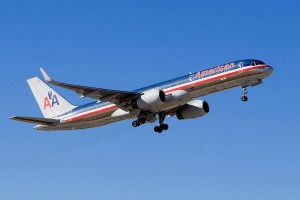
American Airlines Boeing 757. Photo from aa.com.
One of my least favorite things about air travel is waiting in line. Wait in line to check-in, wait in line for security, wait in line to get on the jetway, and wait in line to actually get on the plane. When the electronic kiosks first came out, I loved them. Most people didn’t understand them and didn’t use them, so there was normally no line at all. Now they are the norm, and I am back to waiting in line.
American Airlines is looking to add a new option. They are testing a pilot program (or more like “agent program” heh) over the next six weeks at Boston’s Logan International Airport where standing in line might have more options. Starting next week the airline will test 20 mobile devices called Your Assistance Delivered Anywhere (YADA). They will allow passengers to print boarding passes and make upgrades pretty much anywhere in the airport they can find a YADA representative. After the six week test, they hope to roll out the devices nationwide.
This seems like an interesting concept. If it works, not only could it alleviate lines, it could provide more of a one-on-one relationship with American and its customers.
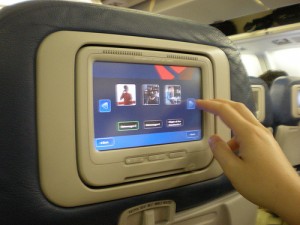
Delta Air Lines's in-flight entertainment system. AirlineReporter.com pic.
On a recent flight from Tampa, FL to Seattle, WA, I stopped and observed the other passengers on-board and what they were doing to entertain themselves. On each flight you normally can find the following:
* Sleepers: They don’t want overhead announcements, they don’t want food/drink service, they just want to sleep.
* iPodders: Just sit there listening to their iPod, sometimes with the occasional head-bob to the music.
* Readers: The flight provides a good opportunity to catch up on some reading.
* Talkers: Will talk to someone they know or spend the flight trying to make new friends.
* Laptoppers: Working on projects and now some on the internet.
* Gamers: With their mini-game systems or using their phones to play games.
* Thinkers: People that spend the time staring at their seat back thinking about who knows what.
* Movie Watchers: Will watch any movie being played by the airline.
* Seat back Players: Passengers who will use the airline’s in-flight entertainment to pass time.
* Combos: Tries to do as many of the different activities as possible before the flight ends.
Over the years, there has obviously been a shift. Years back, there would only be the readers, talkers, sleepers, and occasional movie watchers (if it was offered). Now airlines are providing many more options for flyers. From in-flight entertainment, to movies, to now having the internet, there are quite a few options.
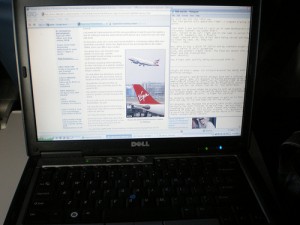
It is not easy to fit a laptop on the tray to blog
I often wonder if the millions invested in in-flight entertainment is going to pay off. With so many hand-held gadgets available(iPod, iPhone, laptops, etc) and the addition of Wi-Fi on many airlines now, are flyers still going to be interested in using the airline’s content?
With a device hooked up to the internet, options are almost limitless and on par with entertainment options on the ground. Airlines are able to charge for internet and movies, but so far, power (which will be available on many more planes in the future) and the ability for a passenger to watch something on their own gadget, are free. As the line between phone, mp3 player and computer continues to blur, it seems less likely that passengers would have an interest in paying for limited content on airlines.
I don’t think the concept of in-flight entertainment provided by the airlines will die, but I think it needs to evolve with the times. Is it worth squinting at a small iPhone screen or dealing with a big laptop in front of me to access free entertainment? If airlines would be able to provide more than just TV and movie options (maybe provide the option to interact with other passengers or order food from their seats) could it sway users back to in-flight entertainment? With the addition of Wi-Fi, it would also be beneficial for airlines to integrate the internet into their in-flight systems and charge customers for using it.
However, is it worth it to airlines to pay to keep up with gadgets? In-flight entertainment systems do not come cheap. Airlines, having to foot the initial set-up cost to get airplanes retrofitted with the new technology, still must pay to keep them updated, they pay for additional fuel burn from the weight, and they pay for licensing fees to show certain TV shows and movies. Is it worth it to put that much money into a system, when passengers can provide the technology themselves and airlines can charge for access to the internet, possibly rent movies onboard (either DVD or via network download), and maybe even charge for power usage?

Three videos that teach you Wi-Fi do's and don'ts
A while back I was able to fly to Baltimore and be a part of AirTran’s wifi unveiling. I was excited to see the new technology first hand, but was disappointed when my AirTran flight back to Seattle didn’t have WiFi. Well, now there is no more wondering! 100% of AirTran’s planes now have WiFi. The beauty of all aircraft on a single airline having WiFi, is you no longer have to wonder. You know by flying on AirTran or Virgin American you will be able to enjoy WiFi.
To assist with folks getting use to having the internet in close proximity of other people, AirTran has created a website to teach you about Internetiquette (awesome word). It has three funny videos and an online brochure. Bonus points for anyone who can take a picture while looking at these on an AirTran flight!

The days when the airline would help you light up.
The Gadling is reporting that entrepreneur Alexander Schoppmann is hoping to start a smoking-only airline. Schoppmann is currently looking for capital to start Smintair (which stands for Smoker’s International Airways).
The new airline is not looking to cater to the average working Joe, but to people with some extra cash. The airline will only have First and Business class. The airline is planning to have two Boeing 747’s flying from Europe to Japan. The concept is to have no seats on the upper deck and for it to be a lounge. New ventilation systems would be installed on the aircraft allowing for better fresh air recirculation on the smoke-filled flights. Schoppmann is hoping to have the airline up and running by next summer.
Can this concept work? Maybe. There is a much larger smoking population in Germany and Japan than in the US. Also, with the economic crunch a lot of companies are cutting out their business jets and this might provide a cheaper alternative. It would be like an exclusive country club in the air and probably big business deals could take place in mid-flight. It will be interesting to see if Smintair will ever take off — other sites were reporting the first flight was supposed to be December 2007, so we will have to wait and see!
Image: theage.com.au






